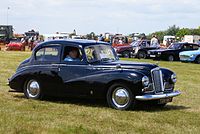
The Hillman Minx was a mid-sized family car that British car maker Hillman produced from 1931 to 1970. There were many versions of the Minx over that period, as well as badge-engineered variants sold by Humber, Singer, and Sunbeam.

Sunbeam Motor Car Company Limited was a British automobile manufacturer with its works at Moorfields in Blakenhall, a suburb of Wolverhampton in Staffordshire, now West Midlands. Its Sunbeam name had been registered by John Marston in 1888 for his bicycle manufacturing business. Sunbeam motor car manufacture began in 1901. The motor business was sold to a newly incorporated Sunbeam Motor Car Company Limited in 1905 to separate it from Marston's pedal bicycle business; Sunbeam motorcycles were not made until 1912.
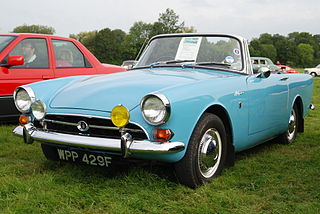
The Sunbeam Alpine is a two-seater sports roadster/drophead coupé that was produced by the Rootes Group from 1953 to 1955, and then 1959 to 1968. The name was then used on a two-door fastback coupé from 1969 to 1975. The original Alpine was launched in 1953 as the first vehicle from Sunbeam-Talbot to bear the Sunbeam name alone since Rootes Group bought Clément-Talbot, and later the moribund Sunbeam from its receiver in 1935.

The Sunbeam Rapier is an automobile produced by Rootes Group from 1955 until 1976, in two different body-styles, the "Series" cars and the later (1967–76) fastback shape, part of the "Arrow" range.

The Riley RM Series is an executive car which was produced by Riley from 1945 until 1955. It was the last model developed independently by Riley prior to the 1952 merger of Riley's still new owner Nuffield, with Austin to form BMC. The RM series was originally produced in Coventry, but in 1949 production moved to the MG works at Abingdon. The RM models were marketed as the Riley 1½ Litre and the Riley 2½ Litre.

The Humber Super Snipe is a car which was produced from 1938 to 1967 by British-based Humber Limited.

The Lagonda 2.6-Litre was an automobile produced in England by Lagonda from 1948 to 1953. It was the first model from that company following its purchase by David Brown in 1947, and was named for the new straight-6 engine which debuted with the car. The Lagonda straight-6 engine was designed by W. O. Bentley and would propel Lagonda's new parent company, Aston Martin, to fame.

The Lagonda 3-Litre is an automobile which was produced by Aston Martin Lagonda from 1953 until 1958. It was the second Lagonda model of the David Brown/Aston Martin era. The 3-Litre was fitted with a higher displacement 2.9 L 140 bhp version of the twin overhead camshaft Lagonda Straight-6 engine designed by Walter Owen Bentley.

The Daimler Conquest is an automobile which was produced by The Daimler Company Limited in the United Kingdom from 1953 to 1958. Based on the Lanchester Fourteen, the Conquest replaced the Daimler Consort. Sales were affected by increasing prices and by the fuel shortage caused by the Suez Crisis, and production ended by January 1958, before a replacement model was in production.

The Standard Vanguard is a car which was produced by the Standard Motor Company in Coventry, England, from 1947 until 1963.
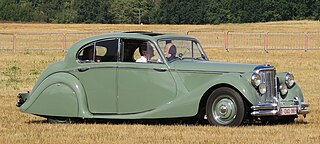
The Jaguar Mark V is a luxury automobile built by Jaguar Cars Ltd of Coventry in England from 1948 to 1951. It was available as a four-door Saloon (sedan) and a two-door convertible known as the Drop Head Coupé, both versions seating five adults. It was the first Jaguar with independent front suspension, first with hydraulic brakes, first with spats, first specifically designed to be produced in both Right and Left Hand Drive configurations, first with disc centre wheels, first with smaller wider 16" balloon tyres, first to be offered with sealed headlamps and flashing turn signals for the important American market, and the last model to use the pushrod engines.

The Humber Hawk is a four-cylinder automobile manufactured from 1945 to 1967 by British-based Humber Limited.
British Light Steel Pressings Ltd was a company at Warple Way, Acton, London producing bodies for the vehicle industry.
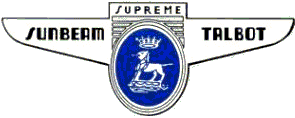
Sunbeam-Talbot Limited was a British motor manufacturing business. It built upmarket sports-saloon versions under the parenthood of Rootes Group cars from 1938 to 1954. Its predecessor Clément-Talbot Limited had made Talbot automobiles from 1902 to 1935.

The Hillman Super Minx is a family car which was produced by Hillman from 1961 to 1967. It was a slightly larger version of the Hillman Minx, from the period when the long-running Minx nameplate was applied to the "Audax" series of designs.
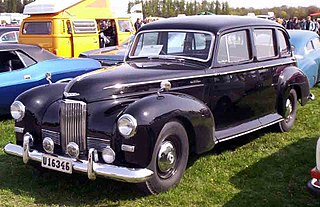
The Humber Pullman is a four-door limousine which was introduced by the British Humber company in 1930 as a successor to the Humber 20/65 hp and long-wheelbase version of the Humber Snipe.

The Hillman Fourteen is a medium-sized 4-cylinder car announced by Hillman's managing director Spencer Wilks, a son-in-law of William Hillman, at the end of September 1925. This new Fourteen substantially increased Hillman's market share and remained on sale into 1931. During this time it was the main product of the company.

The Sunbeam-Talbot Ten is a compact executive car or small sports saloon manufactured by Rootes Group in their Clément-Talbot factory in North Kensington between 1938 and 1939, and then reintroduced after the Second World War and sold between 1945 and 1948. It was at first a two-door then a four-door sports saloon. A drophead coupé version and a sports tourer version were also available.

The Sunbeam-Talbot 2 Litre is an automobile which was manufactured by Sunbeam-Talbot in the United Kingdom from 1939 until 1948. It was offered in 4-light sports saloon, foursome drophead coupé and 4-seater sports tourer body styles as well as a sports 2-seater. Production was suspended due to the Second World War and was resumed in 1945.

The Sunbeam-Talbot 80 is a 4-door 4-light sports saloon which was produced by English manufacturer Sunbeam-Talbot from 1948 to 1950.











